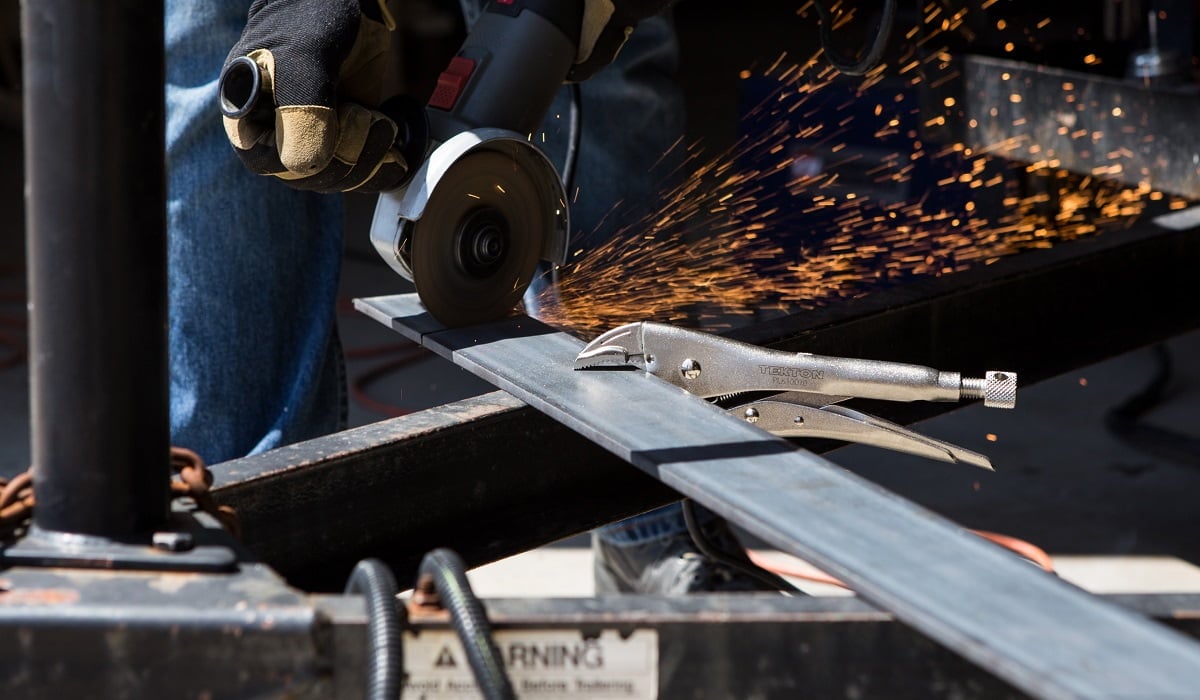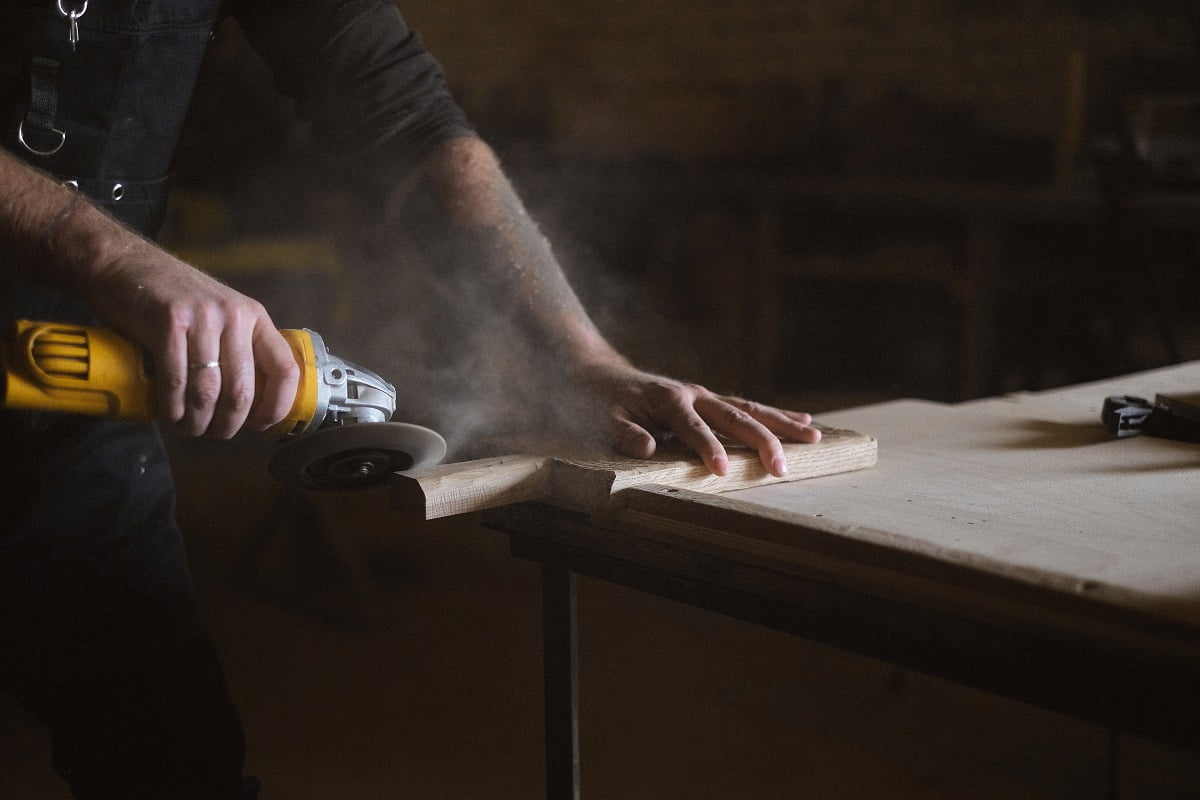An angle grinder must be used at the right angle and with the right pressure for the particular job. At the same time, you must maintain all the safety precautions to use the tool for cutting or grinding different materials with ease.

There’s no denying that an angle grinder can be a very useful tool for cutting through metals and other materials. However, using the tool properly is the key.
And without the proper knowledge, even the best power tools won’t work well and become a threat to you. So, today, we will tell you all about how to use an angle grinder and what are the important points that you must keep in mind for the best results.
How To Choose An Angle Grinder?

As you may already know, an angle grinder is a versatile tool that can help users tackle multiple tasks like sharpening your lawn mower blade, cutting metal, or removing excess mortar and cutting through rusted bolts. Besides, you can use it on flammable materials, sheet metal and more.
Depending on the type of task, the angle grinder can be equipped with either a cutting wheel or a grinding disc.
For example, if you're working on wooden projects or plan on using one as part of your regular work, look for one with a larger blade size so that the tasks can be completed quickly.
But if you want to use an angle grinder for metalworking projects such as cutting down rebar or welding together pieces of scrap metal (like when building fences), then opt for a model with a shorter blade. Aside from that, choose an angle grinder that has a good quality motor with smooth bearings and the best angle grinder attachments so that it runs quieter and smoother. This will make it easier to control when working with heavier materials like stone or concrete—and easier on your arms!
If you're looking for versatility (or if the tool is going to be used by multiple people), get one with variable speed control settings. And always start with the lowest speed setting to reduce the chances of injuries.
Steps To Use An Angle Or Hand Grinder Correctly
First and foremost, make sure the angle grinder is set up for your needs. For example, if you're using an electric angle grinder and need to get into tight spaces, choose a smaller disc with less power. Likewise, if you want to work on metal or concrete surfaces, we’d advise going with an aluminum oxide grindstone disc rather than diamond grit one.
Next and most importantly: wear personal protective equipment like work gloves, as some materials can cause injury even if they don't cut your hands open immediately. And you may also choose to wear ear mufflers, too.
Aside from that, don’t forget to use the blade guard attached properly, especially when cutting steel.
Step 1
Make sure the angle grinder is switched off unless you’re completely ready to use it. Otherwise, you may risk injuries and damages from the sudden spinning blade or grinding wheel.
Step 2
Make sure you have a firm grip on the tool at all times so that it doesn't slip out of control , especially when working with maximum speed on the electric motor. We’d strongly recommend clamping down the material on the work surface so that it doesn’t move when you start working on it.
Step 3
Make sure that you are using the right size disc for the job, which is suited for the job and rated for use with the particular model of the angle grinder. Using the wrong disc can result in overheating or electric shock, both of which can be dangerous and cause injury or death.
Step 4
Clean the sides of the disc and spindle nut with a wire brush so they're nice and shiny. This will help prevent overheating (which can damage your tool) as well as reduce friction (which could cause slippage during operation).
Step 4
Now, hold the angle grinder with both hands. This way, you will have a firm grip on the same and will be able to operate the machine in a safe way. Never take your hands off the machine as that might lead to serious injuries.
Allow the angle grinder to reach its full speed before you make it come in contact with any metal or wood. This will ensure the optimum production of your machine for rendering precision cuts.
As for the pressure application, we’d suggest starting with light pressure, unless you’re working with a thicker material. You can always apply more pressure later to achieve the desired result.
Step 6
Always keep the cutting disc moving so as not to leave any part of yourself exposed for too long.
Step 7
While the movement of the cut will depend on the cut you’re making, keep rotating the disc slowly in circular motions in order to maintain control over it while working.
Safety Precautions To Be Kept In Mind
Safety is important to everyone, but it's especially important when operating a power tool like an angle grinder.
Hence, always ensure that you wear the right-sized safety goggles before starting out. It's also a good practice to wear long sleeves and pants while using one. All these will help minimize your exposure to the flying debris while cutting or grinding the materials.
On that note, grab a dust mask if you don’t want to inhale the smaller particles.
Another thing to keep in mind is that using an angle grinder around construction sites will need you to be more careful. Loose clothing, like jackets or pants flapping around can become entangled with rotating parts or the lawn mower blades within your tool's housing causing injury if not careful enough attention paid!
Is A Wire Brush Compatible With An Angle Grinder?
Many users who have started using angle grinders or know of its versatility ask “how to install a wire brush on an angle grinder?”
The answer to this is yes, you can. However, you first need to determine whether your angle grinder is compatible with one by checking the diameter of your current rotary tool. If it measures between ¼ and ½-inch in size, then it should be able to support a wire brush attachment. If not, consider upgrading to a more powerful machine with larger dimensions.
For the unversed, a wire brush is a tool used for cleaning and polishing metal objects. It consists of a piece of wire with abrasive tips that removes rust, dirt, paint and other particles from surfaces.
Wire brushes are made from different kinds of metal wires such as steel or brass. They can be attached to an angle grinder using a wrench or Allen wrench depending on the type of attachment you need.
These brushes come in several different sizes, each with its own set of uses. So, you should know what type of brush is right for your needs before using it.
Firstly, you need to determine the size of the brush, as they come in different diameters. And you’d want to get one that fits your machine perfectly so that it doesn't slip or fall off when using it on different surfaces.
To determine what size of wire brush you need, just measure around the circumference of your current one and then add 2-3 cm (1 inch) for good measure.
If you don’t have an angle grinder and are considering purchasing one, we highly recommend it. This is because the standard drill bit that comes with most corded drills mayl wear out quickly when used for installing wire brushes.
That’s why you'd want a sturdy tool like an angle grinder that can withstand constant downward pressure (as the bit works its way on the surface).
How To Install The Wire Brush On Your Angle Grinder?
Before you start, you will need to determine how the brush attaches to the grinder. This can be in a variety of ways, but there are a few general rules to follow.
For one, if the brush is a large screw-on attachment or has threads on its backside, it will probably go overtop of the handle of your grinder. But if it has two holes for screws and no threading on its backside, then it will likely be held in place with two metal clamps that go around the handle of the grinder.
Once you’ve determined the installation spot, secure the brush onto your angle grinder using a wrench. For this, loosen the nut on the rear of the angle grinder, which is located behind the wheel guard and in front of the power cord. Then, slide the brush into place between this nut and its housing.
Make sure that there's enough room for you to tighten it later, but don't over tighten it. You’d still want to be able to get both hands on it easily when you're installing or removing it from the angle grinder.
Next, you need to set the angle grinder at the right speed for the job. This will depend on the type of material you're cutting and how hard it is.
Generally speaking, a slower speed will make it easier for the brush to cut through whatever you're working on. However, if you start with a higher RPM (revolutions per minute) for a material that’s too soft or thin, it may get damaged.
Moreover, the angle grinder may end up getting overheated to interrupt your work. Not only that, but it may also get damaged prematurely.
To determine what speed will work best for you, try taking an old piece of metal that has been painted over many times. Use the brush attachment on it at different speed settings until you find one that works well enough but doesn't damage the metal.
Is Your Angle Grinder Compatible With Different Accessories?
Another thing that you’d want to check is if your power tool has any existing mounting holes on its body that would allow for easy installation of an accessory such as a wire brush. If not, don't fret! You can still add one by drilling through the center of its side handle—but doing so will require some extra work on your part.
This will require buying some drill bits, based on the size of the slots or holes that you need to make. Make sure that the drill bits should be able to hold up against whatever type of material makes up the attachment's outer casing (aluminum or steel).
Can You Use An Angle Grinder On Wood?

Another very frequently asked question is can you use an angle grinder on wood? Well, if you're an experienced carpenter or keen DIYer, you'll probably already be aware that angle grinders aren't just for cutting through metals! These powerful tools can also be used to cut wood, so long as you take the necessary precautions.
However, the speed of the blade determines its power when working on wood. The faster the blade spins, the more powerful it is and the better it can cut through different densities and thickness of wood.
Apart from that, there are a few other factors to look into before starting work.
For example, you should first consider the type angle grinder that you need for the job. Electric angle grinders are generally more popular and powerful, but they cannot be used in wet conditions. On the other hand, compressed air-powered angle grinders are less powerful but can operate in wet conditions.
The second thing to know is that electric grinders tend to be quieter than their pneumatic counterparts. This can be a great advantage if you will be working on your lawn or an open space without troubling the neighbors too much.
Using Angle Grinders For Sanding Wood
Many DIY enthusiasts and even professionals prefer using angle grinders to sand wooden surfaces. This is a good way to smoothen out the surface as well as remove marks and stains before using the wooden blocks or slats for building furniture or fences, among other things.
The best disc for this purpose is a flap disc, which is made from overlapping sandpaper sheets surrounding its center. It has a large surface area to sand more wood at one go, helping you complete the job quickly and more efficiently. Besides, it’s among the most inexpensive angle grinder attachments.
Flap discs come in different variants depending on their thickness (or grit), so you can choose one according to the thickness of the wood.
Are There Any Limitations To Consider?
Of course, there are some limitations when cutting wood with an angle grinder. For example, an angle grinder will struggle with hardwoods as they are too tough and dense for the tool to cut through easily.
So, be careful when using an angle grinder on wood, and make sure you follow all the safety tips we've given above. If you're not sure how best to use your angle grinder with wood, then seek expert advice from someone who has used it before.

How To Use An Angle Grinder Conclusion
That’s everything we had for you today!
It’s true that angle grinders aren’t very difficult to operate, but that doesn’t mean you should let your guard down at any point. If you think you're losing control of the tool, switch off the power immediately and readjust the grip or angle.
Likewise, if the blade is vibrating too much, switch off the grinder, let the blade stop completely, and use the angle grinder tools to tighten it. This should put you back on track!
We will be back with more such reads. Till we meet again!
